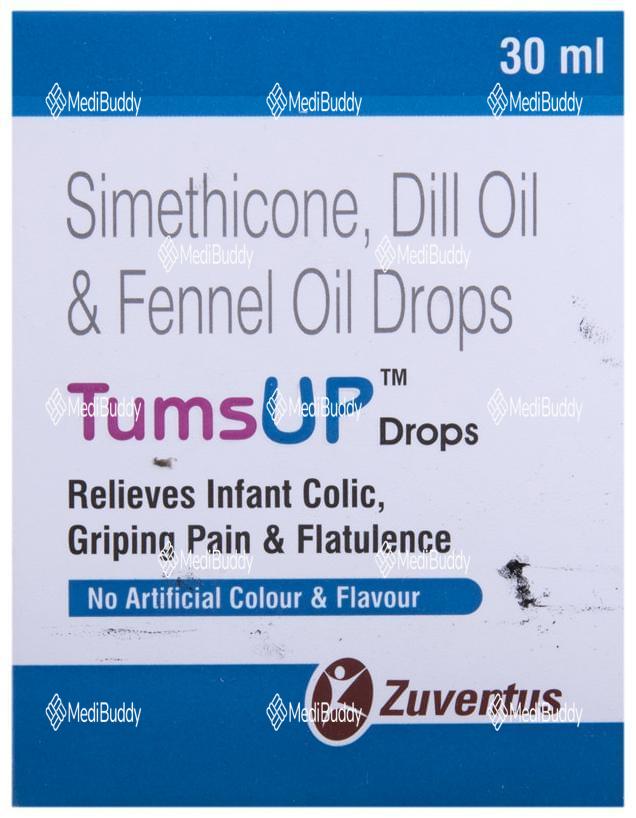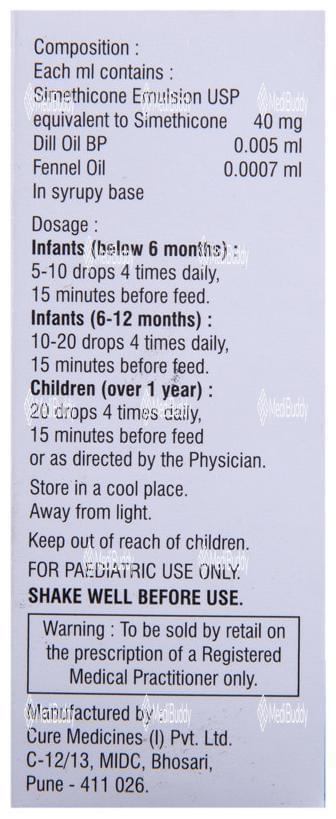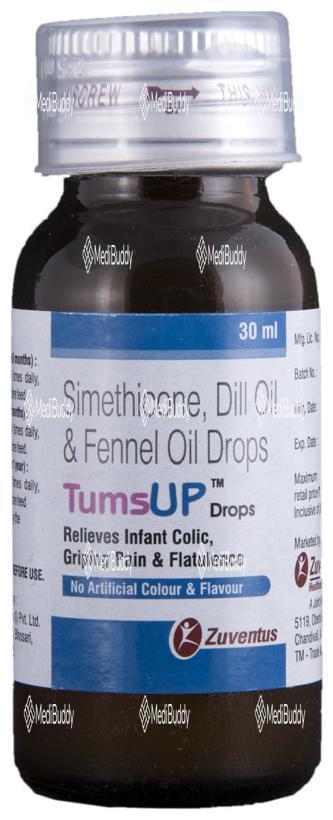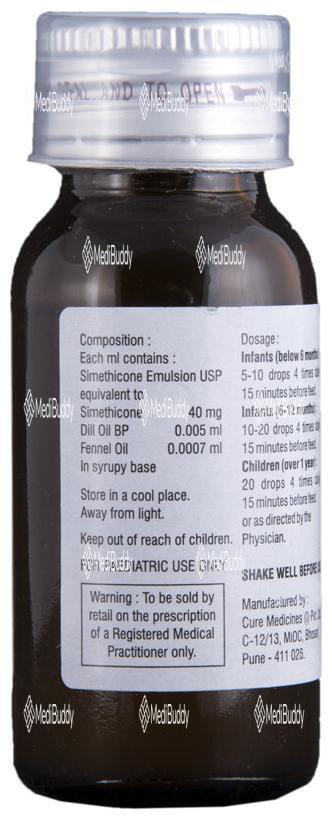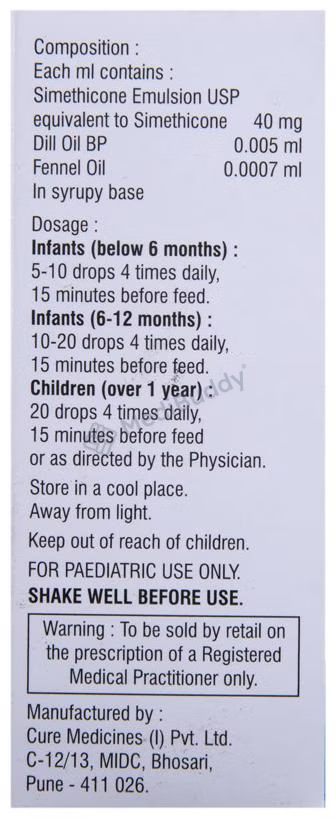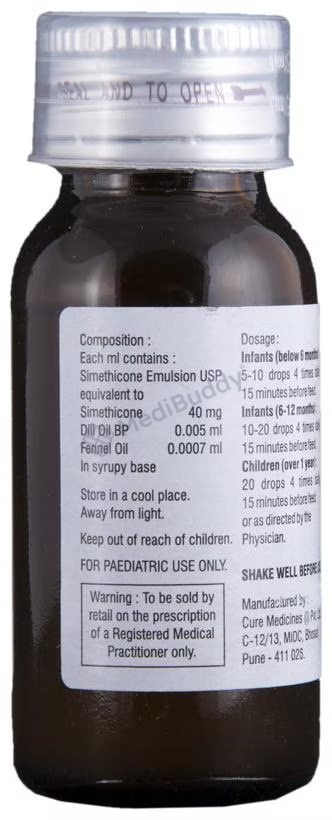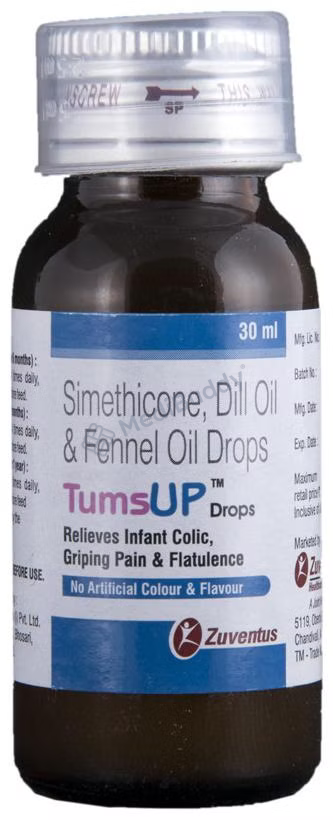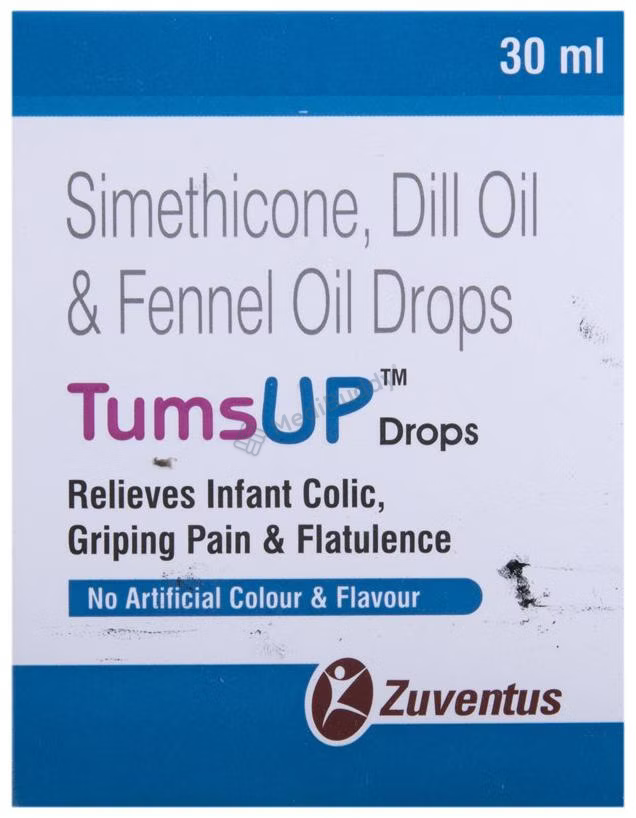Tumsup Drop
By Tumsup
30ml Drop in a Bottle

Composition
Dill Oil(0.005ml) + Fennel Oil(0.0007ml) + Simethicone(40mg)

Manufacturer - Zuventus Healthcare Ltd
Office No. 5119, 5th Floor, 'D' Wing, Oberoi Garden Estates, Chandivili, Andheri (E), Mumbai - 400 072.

Expires on or after
November, 2025
About Tumsup Drop
Tumsup Drop is a medication designed for children to alleviate symptoms such as abdominal pain, bloating, discomfort, and cramps. It achieves this by neutralizing excess acid in the stomach and aiding in the smooth passage of gas. Furthermore, it helps relieve spasms by relaxing the muscles in the stomach and gut. It is recommended to administer Tumsup Drop orally to your child, either before or after meals. If stomach upset occurs, it is preferable to give it after food. Typically, it is administered 4 to 5 times a day after meals, although the dosage may vary based on factors such as the child's clinical condition, body weight, and age. Abruptly stopping the medication could lead to a recurrence or worsening of symptoms, so it is crucial not to discontinue it without proper guidance. In case of vomiting within 30 minutes of ingestion, the dose can be repeated, but double dosing should be avoided if the next dose is due.
The formulation of Tumsup Drop comprises Dill oil, Fennel oil, and Simethicone, which belong to specific categories of medicines known as Antiflatulents, Carminative agents, and Anti-foaming agents, respectively. This medication is indicated for infants and children to address conditions like infantile colic, gas, stomach pain, cramps, bloating, indigestion-related discomfort, and regurgitation. It also assists in managing constipation, gastric infections, and loss of appetite due to gastric issues. To reduce bloating and gas problems, it is advisable to steer clear of caffeine, chocolates, beans, fizzy drinks, spicy foods, and sprouts. Individuals with liver or kidney problems, diabetes, vomiting, ileus, or obstructive gastrointestinal colic should avoid taking Tumsup Drop.
Before initiating Tumsup Drop therapy, it is essential to inform your doctor if you are undergoing treatment for thyroid disorders. Some common side effects associated with Tumsup Drop include nausea, headache, loose stools, and constipation. If any of these symptoms worsen, it is advisable to seek medical advice promptly. Keeping your child's doctor informed about all medications being consumed by your child, as well as any history of allergies, food intolerances, abdominal issues, liver impairments, kidney dysfunction, or birth defects, is crucial for tailoring appropriate dosages and planning an effective treatment regimen.
Benefits
Tumsup Drop is a reliable solution for addressing abdominal pain in children. It works effectively by easing sudden muscle spasms and contractions in the stomach and intestines. By doing so, it helps relax the muscles and enhances the movement of food through the digestive system. This results in alleviating symptoms such as abdominal pain, cramps, bloating, and discomfort. With the use of Tumsup Drop, your child will experience improved comfort and relief, enabling them to engage in daily activities with greater ease. This effective relief can contribute to enhancing your child's quality of life, fostering a more active and healthy lifestyle.
How to use the Tumsup Drop
To use Tumsup Drop, follow your doctor's instructions carefully. Shake the bottle well before using the drop. Your physician will determine the right dose and how long you should take it based on your age, weight, and health condition. Remember to take Tumsup Drop with food. Before using the drops, always check the label for guidance and use the marked dropper to measure the correct amount. By following these steps and taking Tumsup Drop as directed by your doctor, you can get the most benefit from this medication.
Uses of Tumsup Drop
Tumsup Drop can be used for the treatment of various digestive issues such as abdominal pain, bloating, discomfort, and stomach pain. It helps relieve stomach cramps, enhances digestion, and reduces flatulence (gas) by providing relief from stomach upsets. The drops are also beneficial for managing infantile colic, loss of hunger caused by excess gas in the stomach and intestine, regurgitation (spitting up food from the stomach or oesophagus), gastric infections, and constipation.
What conditions Tumsup Drop treats?
Tumsup Drop is prescribed to children for easing abdominal pain, bloating, discomfort, and cramps. It works by neutralizing excess stomach acid, facilitating gas passage, and relieving spasms in the stomach and gut muscles. Administer it orally, before or after meals, usually 4 to 5 times a day. Adjust dosage according to your child's clinical condition, weight, and age. Do not halt the medicine abruptly, as symptoms may reoccur or worsen. Inform the doctor about existing medications, allergies, digestive issues, or other health conditions for proper treatment planning.
Should you consult a doctor?
Seek immediate medical attention from a doctor if you experience vomiting, inability to tolerate oral intake, or gastrointestinal blockage while taking Tumsup Drop. It is also essential to consult your doctor before taking Tumsup Drops if you are undergoing treatment for thyroid disorders. In pediatric cases, it is safe to give Tumsup Drop to infants and children, but it is advisable to seek advice from a doctor beforehand. If you have diabetes or are unsure about using Tumsup Drop, do not hesitate to seek medical guidance.
Side effects of Tumsup Drop
While Tumsup Drop is generally well-tolerated by children, there are potential side effects to be aware of. The most common side effects reported are nausea, headache, diarrhea, and constipation. However, these side effects are usually mild and may go away as your child's body gets used to the medication. If these side effects persist or become bothersome, it is recommended to seek advice from your child's doctor. In rare cases, serious side effects may occur that require immediate medical attention. These include developing an itchy, red, swollen, blistering, or peeling skin rash, swelling in the lips, tongue, mouth, face, throat along with breathing or swallowing difficulties, wheezing, and tightness in the chest or throat. If any of these severe side effects occur, stop taking Tumsup Drop and contact your doctor right away.
Safety advice

liver
Tumsup Drop is considered safe for use in individuals with liver disease, and there is no need to adjust the dose of the product for this condition. However, it is advised to consult with your child's doctor specifically if there are concerns related to severe kidney disease.

kidney
Tumsup Drop is considered safe for patients with kidney disease. No dose adjustment is needed but consult your child's doctor in cases of severe kidney disease.
Consumption warning before consuming Tumsup Drop
Before giving Tumsup Drop to your child, ensure it is administered by mouth either before or after food. It is recommended to give it after food if stomach upset occurs. The usual dosage is 4 to 5 times a day after meals, but this may vary based on your child's clinical condition, body weight, and age. Do not abruptly stop the medication as it could worsen symptoms or the child's condition. In case of vomiting within 30 minutes of intake, comfort the child and repeat the dose. However, do not double the dose if it is close to the next scheduled dose. Inform your child's doctor about all medications your child is taking, along with any history of allergies, food intolerances, abdominal issues, liver or kidney problems, or birth defects. This information is crucial for determining the right dose and overall treatment plan for your child.
What if you forgot to take Tumsup Drop?
If you forget to give your child a dose of Tumsup Drop, don't worry. Once you remember, give them the missed dose right away. However, if it's nearly time for the next scheduled dose, skip the missed one. It's important not to double the dose. Simply continue following the dosing schedule as prescribed.
What happens if you take overdose of Tumsup Drop?
In the event that someone takes too much Tumsup Drop, it is essential to seek prompt medical attention from a doctor. An overdose of Tumsup Drop may lead to various symptoms such as headaches, stomach upset, diarrhea, and constipation. If you or someone you know experiences these signs after consuming an excessive amount of Tumsup Drop, it is crucial to get medical help right away.
Additional Information
| Habit Forming | No |
| Chemical Class | - |
| Therapeutic Class | GASTRO INTESTINAL |
| Action Class | - |
FAQs
Disclaimer
The information provided on this website is to the best of our abilities to ensure it is accurate, reliable, and reviewed by a team of professionals. It should not be used to diagnose, prevent, or cure any health problem. The information presented here is not intended to create a doctor-patient relationship or replace a registered medical practitioner's advice, diagnosis, or treatment. The absence or provision of any information or warning regarding any medicine should not be assumed as an implied or explicit assurance of safety or efficacy. We highly recommend consulting your registered medical practitioner for all queries or doubts related to your medical condition. Do not ignore professional medical advice or delay seeking it based on the content encountered on our website. We intend to support, not replace, the doctor-patient relationship.
₹114.1
Inclusive of all taxes
Content verified by

Dr. Archana Prabhakar
MBBS, M.Med (Family Medicine)
Last update on 01-Oct-2024

